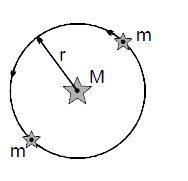Certain neutron stars (extremely dense stars) are believed to be rotating at about 1 revolution per second. If such aa star has a radius of 20 km, the acceleration of an object oon the equator of the star will beSolution in Punjabi
2.0×109ms−2
1.2×107ms−2
8×105ms−2
4×108ms−2
Step by step video & image solution for Certain neutron stars (extremely dense stars) are believed to be rotating at about 1 revolution per second. If such aa star has a radius of 20 km, the acceleration of an object oon the equator of the star will be by Physics experts to help you in doubts & scoring excellent marks in Class 11 exams.
Updated on:21/07/2023Topper's Solved these Questions
Similar Questions
What is centre of mass of a system?
View SolutionA bend in a level road has radius of 100 m.Find the maximum speed with which a car turning this bend may have without skidding ,if the coefficient of friction between the tyres and road is 0.8.
View SolutionIn a binary star system one star has thrice the mass of other. The stars rotate about their common centre of mass then :
View SolutionA pulsar is a rapidly rotating neutron star, the result of the gravitational collapse of an ordinary star that has used up its fuel supply. A certain pulsar has a rotational period of T=0.033 sec and radius R=1//38 km . The tangential speed of a point on the equator is "___________" (km//s)
View SolutionCertain neutron stars are believed to be rotating at about 1rev//sec . If such a star has a radius of 20 km , the acceleration of an object on the equator of the star will be
View SolutionA rotating star has a period of 30 days about an axis passing through its centre. The star undergoes an internal explosion and converts to a neutron star. Initial radius of the core was 1.0xx10^(4) km, whereas, final radius is 3.0km . Determine the period of rotation of the neutron star.
View SolutionA star 2.5 times the mass of the sun and collapsed to a size of 12km rotates with a speed of 1.2 rev. per second. (Extremely compact stars of this kind are known as neutron stars. Certain stellar object called pulsars belong to this category). Will an neutron stars. Certainstellar objects called pulsars belong to this category). will an object placed on its equator remain stuck to its surface due to gravity? (mass of the sun =2xx10^(40)kg ).
View SolutionA pair of stars rotates about their centre of mass One of the stars has a mass M and the other has mass m such that M=2m The distance between the centres of the stars is d (d being large compared to the size of either star) .
The period of rotation of the stars about their common centre of mass (in time of d ,m ,G) is .
View SolutionThe two stars in a certain binary star system move in circular orbits The first star α moves in an orbit of radius 1.00×109km The other star β moves in an orbit of radius 5.00×108km What is the ratio of masses of star β to the star α ? .
View SolutionA pair of stars rotates about their centre of mass One of the stars has a mass M and the other has mass m such that M =2m The distance between the centres of the stars is d (d being large compared to the size of either star) . The period of rotation of the stars about their common centre of mass (in time of d ,m ,G) is .
View SolutionA certain triple-star system consists of two stars, each of mass m, revolving about a central star, mass M, in the same circular orbit. The two stars stay at opposite ends of a diameter of the circular orbit, see figure. Derive an expression for the period of revolution of the stars, the radius of the orbit is r.

View SolutionAt what angular speed of rotation is the surface material on the equator of a neutron star on the verge of flying off the star if the star is spherical with a radius of 18.0 km and a mass of 7.72×1024 kg?
View SolutionA star 2.5 times the mass of the sun and collapsed to a size of 12km rotates with a speed of 1.2 rev. per second. (Extremely compact stars of this kind are known as neutron stars. Certain stellar object called pulsars belong to this category). Will an neutron stars. Certainstellar objects called pulsars belong to this category). will an object placed on its equator remain stuck to its surface due to gravity? (mass of the sun=2×1040kg).
View SolutionA star 2.5 times the mass of the sun which collapsed to a radius of 12 km rotates with a speed of 1.5 rev. per second. (Extremely compact stars of this kind are known as neutron stars. Certain observed stellar objects called pulsars are believed to belong to this category). Will an object placed on its equator remain struck to its surface due to gravity ? (Mass of the sun = 2×1030kg).
View SolutionCertain neutron stars are believed to be rotating at about 1rev//sec . If such a star has a radius of 20 km , the acceleration of an object on the equator of the star will be
View SolutionA pair of stars rotates about a common centre of mass. One of the stars has a mass M and the other has mass m such that =2m. The distance between the centres of the stars is d ( d being large compare to the size of eithe star).
The period of rotation of the stars about their common centre of mass ( in terms of d,m,G) is
View Solution
